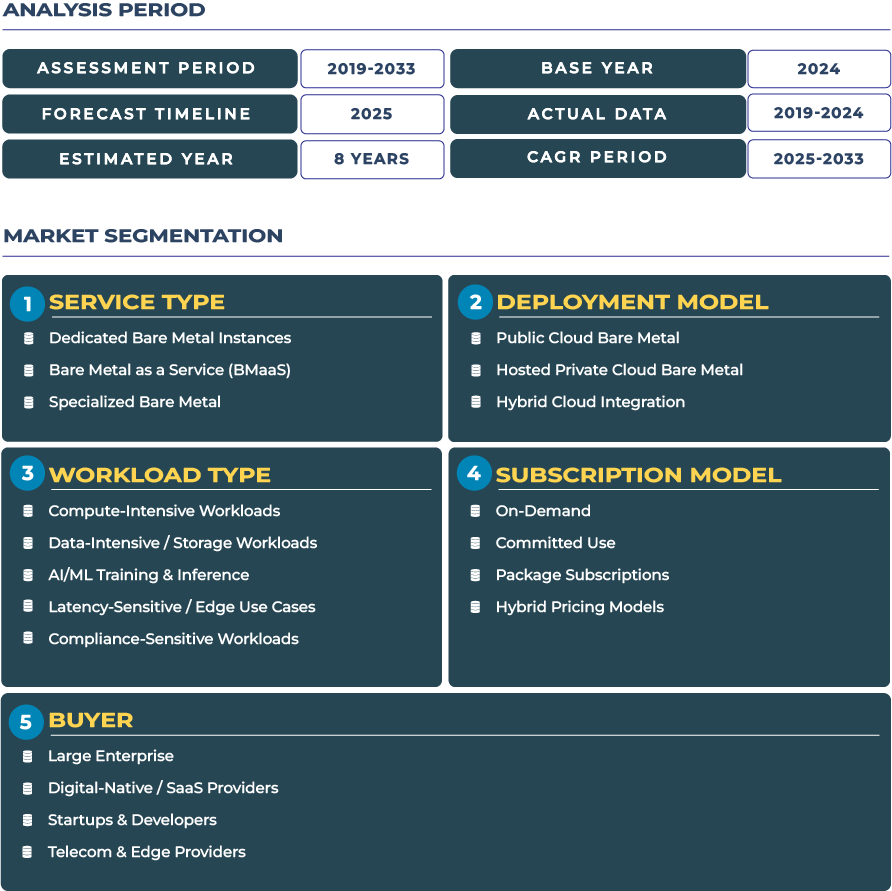Peru Cloud Bare Metal Market Outlook: Edge and Disaster Recovery Bare Metal Driving Strategic Compute Foundations
Peru’s geography-spanning Andean highlands, Amazon basin, and coastal zones-makes latency, connectivity, and resilience central to infrastructure design. In this light, the Peru cloud bare metal ecosystem is evolving toward edge-deployed, disaster recovery–ready bare metal platforms. Enterprises and public institutions increasingly require localized compute nodes to support IoT aggregation, analytics, caching, and rapid failover in the event of disasters. Bare metal nodes at edge sites or secondary cities enhance recovery time objectives (RTO) and reduce dependence on centralized backhaul. The Peru bare metal landscape is thus shifting from purely centralized data centers to a distributed compute fabric that supports business continuity, jurisdictional control, and responsive operations.
The Peru cloud bare metal market is projected to grow from approximately USD 69.7 million in 2025 to USD 235.9 million in 2033, implying a CAGR of about 16.5 %. This expectation aligns with accelerating investment in the Peru data center segment, which is itself forecast to grow strongly. Peru currently houses 16 data centers across multiple providers in Lima and some regional locations. The recent launch of a 20 MW, Tier III data center in Lurín by GTD Signals fresh capacity for advanced compute deployment. Simultaneously, providers such as EdgeUno operate bare metal services in Lima and support regional connectivity. The trajectory assumes maturing orchestration, improved interconnect fabric, and risk mitigation in energy and site infrastructure.
Drivers & Restraints: Forces Shaping Peru Bare Metal Adoption
Driver: Edge Processing & Deterministic Benchmarking Requirements
A core driver is the rise of edge computing and real-time processing, particularly in verticals such as logistics, smart cities, retail, and agro-tech, where sensor data must be ingested, processed, and acted upon locally. Bare metal platforms support deterministic performance and minimal overhead, which is critical for low-latency pipelines. Another driver is the demand for benchmarking, testing, and certification environments-for enterprises evaluating new workloads, hardware configurations, or performance baselines. Bare metal offers consistent, reproducible performance curves that virtualized environments cannot guarantee, attracting firms that require high confidence in latency, throughput, and isolation.
Restraint: Immature Managed Service Stack & Limited Live Mobility
Yet barriers remain. Peru managed service ecosystem for bare metal-including automation, remote provisioning, orchestration, and monitoring-is less mature than in leading cloud markets. Many enterprises expect cloud-style convenience, which bare metal providers must close the gap on. Moreover, live migration or VM-like mobility features are harder to support on physical infrastructure, limiting flexibility for hybrid deployments. These constraints reduce appeal for certain use cases where dynamic workload shifts are common.
Trends & Opportunities: Emerging Patterns and Growth Paths in Peru Bare Metal
Trend: Edge Infrastructure Expansion & DevSecOps on Bare Metal
A notable trend is growing deployment of bare metal at edge nodes, including small data centers, colocation micro-sites, or network aggregation points in Lima’s suburbs and regional towns. These nodes host caching, localized analytics, or IoT gateways. At the same time, DevSecOps and CI/CD pipelines are migrating toward bare metal execution for performance-critical stages-such as build compiles, security scanning, or load testing-because bare metal yields reproducible, cache-warm performance that virtualized instances struggle to match.
Opportunity: Edge Bare Metal for IoT Analytics & Sovereign Compute for Public Sector
One opportunity lies in deploying edge bare metal nodes dedicated for IoT analytics-aggregation, pre-processing, or inference close to sensors in cities or industrial zones. This reduces upstream traffic and improves responsiveness. Another opportunity is for sovereign or government-backed bare metal clouds, especially for public institutions, regulatory agencies, and defense entities seeking local compute isolation, data control, and compliance. These sovereign deployments can leverage local site incentives and institutional trust to bootstrap adoption.
Competitive Landscape: Local Providers, Infrastructure Moves & Bare Metal Adoption Strategies
Peru infrastructure domain includes international colocation and cloud operators, local providers, and specialized hosting firms. EdgeUno, active across Latin America, offers bare metal servers, CDN, and connectivity services-serving Peru among its footprint. Kyndryl has launched a next-generation data center in Peru that accommodates mission-critical and hybrid cloud workloads. Equinix, through its Lima IBX® facility, provides a high-availability, certified infrastructure platform that could host bare metal zones. The GTD 20 MW Lurín project introduces new capacity for dense compute. Competing providers differentiate via features such as flexible billing, edge node reach, managed orchestration, resilience, and compliance certifications. As the Peru cloud bare metal ecosystem evolves, those with integrated compute, network, and service orchestration will lead adoption.







